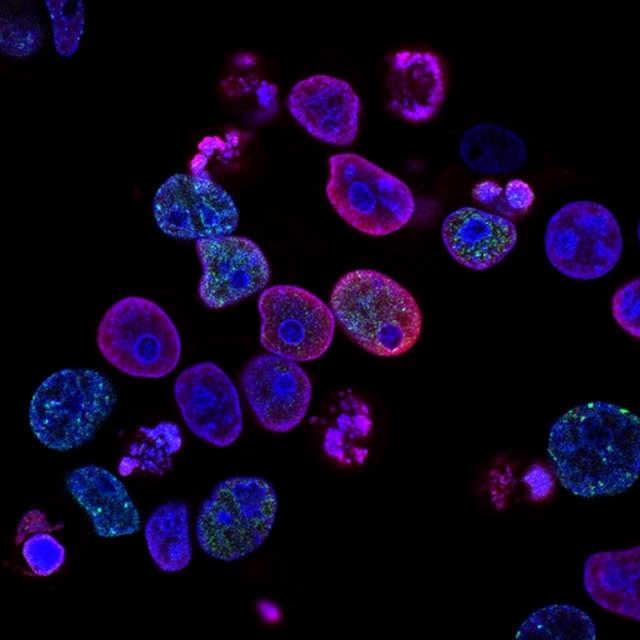A Career in Cancer Research Ends with Long-Awaited Experiments
Laboratory Fellow Karin Rodland retires after 20 years at PNNL

After 50 years in science and on the eve of retirement, Laboratory Fellow Karin Rodland, a cancer cell biologist at PNNL, is working on experiments she has dreamed about for decades: doing proteomics on patients in clinical trials for new cancer treatments.
She measures all the proteins in a patient’s cancer cells before treatment and collects the same data after treatment. Proteins are key machinery that control cell function. Changes in patterns of protein expression can indicate how cancer cells respond—or don’t—to a new medicine.
These large-scale protein patterns, combined with genetic analysis, are the information doctors need to deliver cancer treatments that are most likely to benefit a patient, an approach known as precision medicine.
“I came to PNNL to learn techniques to be able to do these experiments,” Rodland said. During her 20 years at PNNL, including her sabbatical, she has applied advanced tools and innovative experimental designs to identify molecular biomarkers that provide clues to early detection and possible effective treatment of ovarian, breast, endometrial, prostate, and colon cancer. Now those tools, along with genetic sequencing and computational biology, are developed enough for her to tackle her dream experiments.
Rodland officially retired from the lab on June 1st, but she is working part time as a rehired retiree to finish some projects. “I have got to see this through until the end,” she said.

Applying advanced analysis to cancer cell biology
Rodland first came to PNNL in 2000 while on sabbatical from Oregon Health and Science University (OHSU). “I was immediately overwhelmed with the fantastic technical and technological capabilities at PNNL,” she said. “They were so much more powerful than what was out there in academia.”
While studying ways to use plants and microbes for energy production and environmental cleanup, researchers at PNNL were developing state-of-the-art tools in mass spectrometry and nuclear magnetic resonance spectroscopy. These tools allowed them to study the inner workings of cells in atomic- and molecular-level detail.
“They were pushing the boundaries of what was possible to analyze and study in biological and chemical systems,” Rodland said. Her long-standing interest in human health and disease glowed with the research possibilities. “I really, really wanted to have those tools and capabilities applied to biomedical research problems.”
She joined PNNL the next year to work on a U.S. Department of Energy (DOE) systems biology initiative to study microbes that could produce biofuel, clean up toxic chemicals, or sequester carbon. In systems biology, an interdisciplinary team of scientists study everything about how a biological system works, from genetic instructions to protein machinery and biochemical regulatory networks that guide cell and tissue function.
“That was exactly where I was wanting to go with my science,” Rodland said. “It was an approach that really needed to be applied to the cancer space.”
Building a program of biomedical research
Within her first six months at PNNL, Rodland was asked to lead the laboratory’s portfolio of grants from the National Institutes of Health (NIH). “I took that opportunity to build a program of biomedical research here,” she said.
Rodland mentored colleagues in writing proposals for the NIH system, which has different best practices than the DOE system they were familiar with. Demonstrating biomedical relevance is a key part of NIH proposals, which can be a challenge for researchers like those at PNNL, who develop analytical research tools without access to clinical specimens. So Rodland facilitated connections between her laboratory colleagues and her research contacts at universities around the country who needed PNNL tools to answer their biomedical research questions. Finally, she worked with laboratory staff to help them understand best practices for various NIH reports, which also differed from the familiar DOE system.
“Now PNNL is very well recognized by the NIH system as one of the top places for biomedical proteomics,” she said. “I cannot think of a place other than PNNL where I would have had the opportunity to develop the skill set needed to develop a biomedical research program and see it make a difference like it did here.”
In her own research at PNNL, Rodland has advanced tools in protein measurement and computational biology to discern meaningful molecular patterns from a big-picture look inside a cancer cell. Those patterns provide sets of biomarkers that can be used to detect cancer early. She also studies how biomarkers can predict cancer’s response to treatment.
Rodland has a joint appointment as affiliate professor of Cell, Developmental, and Cancer Biology at OHSU, is a fellow of the American Association for the Advancement of Science, a member of the Board of Directors for the U.S. Human Proteome Organization, and serves on the Science Policy Committee for the Federation of American Societies for Experimental Biology.
Published: June 1, 2020